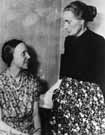
|
|
|

|

|

|

|
|
Click on an image to see a larger, more detailed picture.
|
|
|
|
|
| 1946: The Pursuit of Justice |

|
pg. 642 |

|
|
|
|
| |
 Heinrich Himmler's wife, Marga (right), and daughter, Gudrun (left), were arrested after the war. Placing the families of leading Nazis in custody was a common practice after the war. Although most were never charged with crimes, the Allies suspected that they might know the location of their fathers or husbands, whom the Allies hoped to capture. Marga probably knew little about Heinrich since he paid scant attention to her. He had a mistress 20 years his junior who bore two of his children.
Heinrich Himmler's wife, Marga (right), and daughter, Gudrun (left), were arrested after the war. Placing the families of leading Nazis in custody was a common practice after the war. Although most were never charged with crimes, the Allies suspected that they might know the location of their fathers or husbands, whom the Allies hoped to capture. Marga probably knew little about Heinrich since he paid scant attention to her. He had a mistress 20 years his junior who bore two of his children.
Photo: AP/Wide World
|
 In many instances the Allies were forced to use former concentration camps as DP camps after the war. Residents of the DP camps often turned to arts and crafts to keep themselves occupied. This photograph shows a Rosh Hashana card that Josef Lipnicki made in the Bergen-Belsen, Germany, DP camp.
In many instances the Allies were forced to use former concentration camps as DP camps after the war. Residents of the DP camps often turned to arts and crafts to keep themselves occupied. This photograph shows a Rosh Hashana card that Josef Lipnicki made in the Bergen-Belsen, Germany, DP camp.
Photo: Josef Lipnicki / United States Holocaust Memorial Museum Photo Archive
|
 Zionism
Zionism
The nationalist movement of the Jewish people is known as Zionism. The initial goal of the Zionist movement was to create a national homeland for Jews. Although progress toward this goal was made before 1939, the drive to create a Jewish nation assumed greater urgency after the Holocaust. Throughout the war, Jewish immigration to Palestine was strictly limited by Britain, which held the mandate on the territory. Zionists in Europe, however, worked frantically to smuggle Jews into Palestine, and thousands of Jewish refugees successfully evaded capture by the British. After the war, Zionist activists canvassed the displaced-persons camps, most of which were established in Germany to house Jewish refugees. The activists encouraged survivors of the Holocaust, such as the couple pictured, to immigrate to Palestine. They persuasively argued that only a Jewish nation could guarantee the safety of the Jewish people. Great Britain still refused to open the gates of immigration to Jewish refugees, and they returned most of the 65 refugee ships to Europe. The plight of Jews being turned back from the shores of Palestine contributed to a growing consensus among the world powers that Palestine should become a Jewish state. Subsequent Jewish-Zionist activism, and United Nations support, led to the establishment of Israel in 1948.
Photo: Gedenkstaette Bergen-Belsen / United States Holocaust Memorial Museum Photo Archive
|
|

|

|

|

|
 1946: German geo-politician Karl Haushofer, whose theory of physical space as a vital component of a nation's political power was appropriated and distorted by the Nazis, commits suicide.
1946: German geo-politician Karl Haushofer, whose theory of physical space as a vital component of a nation's political power was appropriated and distorted by the Nazis, commits suicide.
|
 1946: Former Reich Minister of Justice Otto Thierack commits suicide in Nuremberg, Germany, before going to trial for war crimes.
1946: Former Reich Minister of Justice Otto Thierack commits suicide in Nuremberg, Germany, before going to trial for war crimes.
|
 1946: Vojtech Tuka, former prime minister of Slovakia, dies of natural causes before his scheduled execution for deportations of Jews to death camps.
1946: Vojtech Tuka, former prime minister of Slovakia, dies of natural causes before his scheduled execution for deportations of Jews to death camps.
|
 1946: In affidavits, 96,000 former SS men swear they had no knowledge of atrocities committed against Jews and others.
1946: In affidavits, 96,000 former SS men swear they had no knowledge of atrocities committed against Jews and others.
|
 1946: Jews who had escaped the concentration camp at Maly Trostinets, Belorussia, six days before its liberation by the Red Army in June 1944 are released from Soviet-sanctioned confinement in a camp in Siberia.
1946: Jews who had escaped the concentration camp at Maly Trostinets, Belorussia, six days before its liberation by the Red Army in June 1944 are released from Soviet-sanctioned confinement in a camp in Siberia.
|
|
|
|
|
| 1946: The Pursuit of Justice |

|
pg. 642 |

|
|
The Holocaust Chronicle
© 2009 Publications International, Ltd.
|
|
